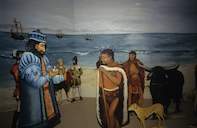Bartolomeu Dias Helps Vasco da Gama
Armed with navigational information that Bartolomeu Dias had collected on his trip, preparations were under way for yet another voyage, in an attempt to negotiate a sea route to the East.

It took some time to set things up, however, and it was only ten years later, in July 1497, that a new captain set off with a small fleet of ships, designed with the help of Dias himself.
The captain’s name was Vasco Da Gama and, as he sailed away from Portugal, he knew the pressure was on.
Columbus had already found his way to Central America in 1492, and the Spanish were busy exploiting the New World as fast as they could. Nevertheless, Portuguese expectations for Da Gama’s expedition were high.
The First Example of African Nationalism
Carefully following in his predecessor’s footsteps, Vasco Da Gama rounded the Cape without major incident and, five months after leaving home, he found himself on the Southern Cape Coast, talking business with some natives.
At first, the gathering was friendly; trading was amicable, there was music and dancing and all seemed to bode well. Then, after a week or so, the natives grew restless and wanted to know when the Europeans were going to leave.
The Portuguese, for their part, had no intention of being told what to do by a bunch of natives and things quickly turned nasty. Da Gama and his men rushed back to the ship and fired their cannons onto the shore as a show of power.
Then, as they sailed away, the Khoikhoi ran out of the coastal bush and knocked down the padrao that Da Gama had just erected. It was probably the first instinctive example of African Nationalism in the face of European conquest – another portent of things to come.
Naming Natal
One month later, Vasco da Gama was still sailing up the coast, looking out at the verdant shore of South Africa’s Eastern seaboard.
On Christmas Day, Da Gama and crew decided to name the land they were passing ‘Natal’ in honour of Christ’s nativity, a name it half-retains to this day.
But, wary of the testy South African locals, Da Gama did not risk landing. Instead, he sailed on and finally anchored off the coast of Moçambique.
The local Bantu tribes in this part of the world were much more tractable than the bolshy Khoikhoi, and Da Gama named the place Terra de boa gente (Land of the Good People).
From the shores of Moçambique, Vasco da Gama discovered the convenient trade winds that blow from the East Coast of Africa, across the Indian Ocean, towards the West coast of Arabia every summer, only to reverse direction and blow back to towards Africa in the winter.
This Aeolian fluke of nature was well known to the early Arabian sea traders who had been plying their wares in Africa since 800CE, and had already established trading stations, like Sofala and Kilwa, along the East coast of Africa.
This trade secret was now in the hands of the Europeans, and they would make full use of it in the years to come.
The Portuguese Takeover
Finally, in May 1498, after 11 months at sea, Da Gama landed at Calicut on the Malabar Coast of Arabia. To celebrate, he seized 7 trading vessels and imprisoned their crews (according to one Arab source), and returned home with the good news and some booty. Within two years, Portuguese ships were sailing to the Indies with regularity.
For the next fifteen years, Portuguese ships continued reaching out across the Indies. First, trading posts were established at Socotra on the Red Sea, then at Hormuz on the Persian Gulf.
These were followed by stations at Goa on the West coast of the Indian peninsula, Malacca in the East Indies (present day Malaysia) and finally on the distant island outpost of Macao, just off the Chinese mainland.
For good measure, they also kicked the Arab traders out of their old trading stations on the African coast and took control of the ancient settlements.
The Sea Route to the East was finally established, and the Europeans had ineluctably entered the building.
 Historically speaking, Mossel Bay is the place where Bartolomeu Dias first planted his European-shod feet on African soil. He took this gian...
Historically speaking, Mossel Bay is the place where Bartolomeu Dias first planted his European-shod feet on African soil. He took this gian... In 1487, a sailor named Bartolomeu Dias set off in a little ship from the seaward shores of Portugal. His goal was to find a sea route to th...
In 1487, a sailor named Bartolomeu Dias set off in a little ship from the seaward shores of Portugal. His goal was to find a sea route to th...